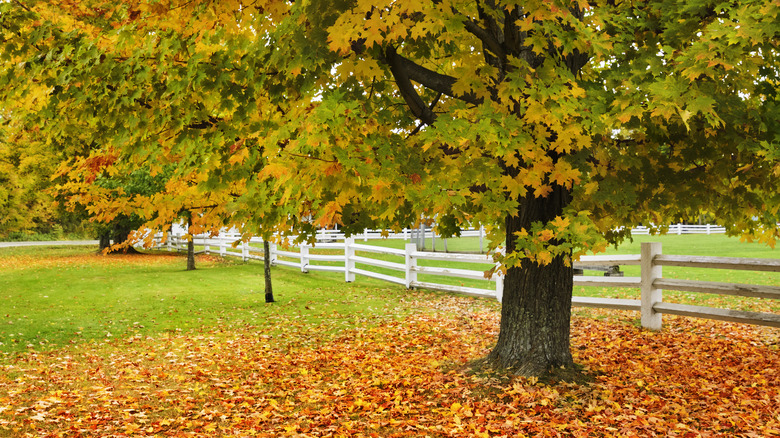Poplar Tree Look-Alikes You Can Grow For Fall Foliage Without The Potential Damage
Poplars look stunning with their smooth, light-colored bark and silvery leaves, but don't be drawn by the siren call of these trees' natural beauty. Despite their elegant and aesthetically pleasing appearance, poplars hide a dark secret beneath the soil, and you should think twice before planting these trees in your yard. Their invasive root systems can spread a distance that eclipses the tree's height — and that's bad news for your home's foundation, as well as nearby properties. The root's aggressive growth can cause foundations to destabilize and crack, so you should avoid planting poplar trees close to the house. The good news is that you can easily avoid these issues by growing poplar look-alikes whose roots pose less of a threat.
Birches and maples are excellent alternatives. Yes, their roots can grow quite large, but they're not considered a danger to foundations. Moreover, these trees provide plenty of shade and aesthetic appeal to your yard. However, choosing birch and maples for your property can be a challenging task, since some of the species are invasive and should be avoided. Below, we'll tell you which of these tree species are native to North America and give you a few key pointers for growing them in your yard.
How to select, plant, and care for birch trees
Before you plant a birch tree in your yard, make sure it's not an invasive species. For example, the tall, slender European birch (Betula pendula) is invasive across various states, making it a poor candidate for growing in your yard. On the other hand, species like the paper birch (Betula papyrifera) and river birch (Betula nigra) are native to North America.
Paper birches will adorn your yard with the distinctive bright-white color of their outer bark. Beneath the white is a layer of brown inner bark, which gets revealed as the outer layers peel off. If you choose to grow this birch species, you can plant it in almost any soil type, provided that it has a somewhat neutral pH level and drains well. A sunny location is the best place to grow birch trees. That said, the trees may need a bit of shade if the summer afternoons are particularly hot. Generally, this birch species flourishes best in cooler regions with mild summers and snowy winters in USDA Hardiness zones 2 through 7.
The river birch may be a more suitable option if you live further south in zones 4 through 9, as it enjoys warmer and more humid conditions than its paper birch cousin. This birch species has gray bark that exfoliates to reveal a beautiful range of colors from beige to purple. The best place to grow this tree on your property is in a sunny, low-lying area adjacent to a water source, or in soil that stays consistently moist.
Choosing and growing maples on your property
Like birches, some maples are invasive in the United States. One notorious example is the Norway maple (Acer platanoides), an aggressive species that forces native plants out. Needless to say, don't grow the Norway maple on your property; instead, opt for a native variety like the sugar maple (Acer saccharum) if you're in the Northeast in zones 4 through 8 or the bigleaf maple (Acer macrophyllum) if you're on the West Coast in zones 6 or 7.
Sugar maples are giant trees that grow as tall as 80 feet and have crowns that easily span over 50 feet. If you choose to plant this beauty in your yard, make sure you've got the room to accommodate its giant size. These maples should be grown in moderately acidic soils (never above pH 6.8) that remain moist, but are never waterlogged or dry. Full sun works best, although some shade is acceptable before the tree is mature. If you're growing this maple on your property, you may have to deal with some pests and illnesses, but your efforts will be rewarded with the unique beauty of this maple's foliage — especially when it turns into a kaleidoscope of color in the fall.
Bigleaf maples are a staple along the Pacific coasts of the U.S. and Canada. These giants reach heights of up to 100 feet at maturity, and can live for up to three centuries. Plant this maple in a spot with moist soil and lots of sun.


